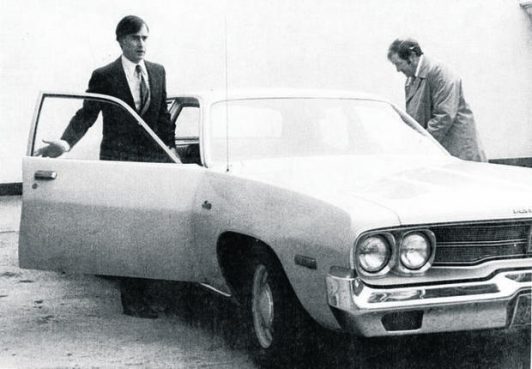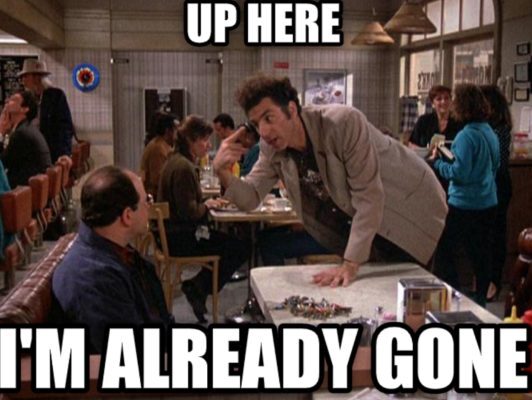Steven Pressfield's Blog, page 5
January 1, 2025
No More Mister Nice Guy
I just came back from vacation and I’m about to plunge in on a Big New Project.
My first note to myself is:
START SAYING NO
I hereby vow to stop saying yes to things.

First, I’ll stop saying yes to things I want to do. My friend Jake, who has tickets to Springsteen? Pass. Sorry, pard.
I’ll go to Lou and Rachel’s wedding. I’ll be there for the festivities after. But I can’t stay out all night, and I won’t do anything that’ll leave me in no shape to work the next morning.
People are gonna get pissed off at me.
I’m sorry.
I’m like the Blues Brothers.
I’m on a mission.
Next I’ll start saying no to deserving invitations. Yeah, I could meet that Australian novelist coming into town, or do a favor for my friend Jeanie’s nephew. But if I say yes to them, I’m saying no to the thing that’s most important to me.
I know what it feels like, at the end of the day, when I’ve said yes to some bogus “opportunity” because I thought I ought to, or I didn’t want to offend someone, or because it seemed like what a Nice Guy would do.
I know what it feels like, at the end of the day, when I haven’t done my work—or slighted the Muse by doing it in some rushed or muddled manner.
I don’t want to feel like that.
I’m on a mission.
I have laid out a block of time, and in that time I have aims I want to achieve.
So things that I might have said yes to last month, I’ll say no to now.
The goal is to build a focus, to establish traction, to work not like an amateur but like a professional.
No more Mister Nice Guy.
The post No More Mister Nice Guy first appeared on Steven Pressfield.December 25, 2024
An Ask Too Far
We said earlier that the playing field for the artist or entrepreneur is not level. Obstacles, often in the form of people seeking their own ends at your expense, are everywhere.
Can you defend your time to work?
Can you teach yourself to say no?

There are people out there who are what I call social sociopaths. They’re not actual murderers or criminals but, for whatever reasons of character or upbringing, they are utterly without empathy. They have no sense of the value of another person’s time or hard-won skill or painfully-earned reputation.
If you’ve got something and they can use it, they want it. They want it now. They want it free. And they want it again and again.
Three days ago I got an e-mail from a guy asking me for thirty free copies of The War of Art. There’s another person who, because of a colleague-in-common, I’ve said a courteous no to more than once. He doesn’t stop. Each ask is followed by another ask. The most recent was an ask to read his book. “It won’t be a problem,” he assured me. “It’ll only take three hours.”
Three hours?
When you respond to an ask from one of these sociopaths, don’t expect gratitude. Instead the initial ask is succeeded by a follow-up ask, and if you’re dumb enough to respond to that, a third ask will appear hot on its heels. Another guy contacted me out of the blue; I did a long interview for him, wrote a foreword for his book and turned him on to my agent. Finally he started asking for favors for his friends.
This was an ask too far. When I said no, he wrote back: “I always knew you were a Hollywood asshole.”
Dude! I don’t live anywhere near Hollywood.
The post An Ask Too Far first appeared on Steven Pressfield.December 18, 2024
Resistance Always Lies
Here’s another way we can use our own Resistance, jiu-jitsu style, and turn it in our favor.
Remember, Resistance is always lying. Every statement it presents to us (I’m talking about the voice we hear in our heads) is the diametric opposite of truth.
If we hear, “You’re not good enough to write this book (or make this movie or start this business),” it’s almost dead-certain that we are.
This principle applies to ALL FIELDS, including those far apart from the arts.

If the voice of our Resistance tells us as we’re signing up for the marathon or the Spartan Race, “You’re not an athlete! Who are you kidding, thinking you can do anything except embarrass yourself?” … it’s almost a lock that we ARE an athlete (or can train ourself to become one.)
Spies and intelligence agents are taught three rules if they’re captured by an enemy:
Admit nothing.Deny everything.Counter-accuse.That’s Resistance’s playbook too. It loves to counter-accuse, i.e. tell us the exact opposite of what’s true.
“You’re not a filmmaker.”
“You have no talent.”
“You can’t stay the course.”
The voice of Resistance in our heads will single out our hidden or as-yet-unrealized strengths and present the opposite as if it were true. It will tell us we’re weak, we’re ungifted, we don’t dare tackle the dreams we feel inside ourselves.
Dismiss this.
Remember: Resistance is ALWAYS lying and always full of shit.
The post Resistance Always Lies first appeared on Steven Pressfield.December 11, 2024
How I Look At Self-Doubt
When I start a new project, I’m invariably crippled with self-doubt.
“Steve, this is a dumb idea. Steve, you’re not good enough to pull this off. Steve, this has been done a million times, blah blah etc.”
This self-doubt stays with me for months. I mean six months, nine months, a year.

This has happened to me on so many projects that I now say to myself, “If I’m NOT experiencing overwhelming self-doubt, something is wrong.”
In other words, I’ve come to consider self-doubt a good sign.
Why? Because self-doubt is one of the weapons Resistance uses against us.
Resistance is trying to undermine our faith in ourselves and our belief in the material.
Therefore, I tell myself, the more self-doubt I’m feeling, the more certain I can be that I’m onto something good.
If I weren’t, Resistance wouldn’t be trying so hard to derail me.
How to overcome self-doubt? We can’t reason or argue our way out of it. Resistance is too diabolical. It will present us with doubt after doubt until it overwhelms us.
The only way is to DISMISS it. “I see you, buddy. You are full of shit and I won’t listen to a word you say.”
Take self-doubt as GOOD and keep on rolling.
The post How I Look At Self-Doubt first appeared on Steven Pressfield.December 4, 2024
Gotta Do It
Continuing our discussion on Resistance “coming second,” i.e. only in response to (and reaction against) a creative Dream … let’s consider what it means when we find ourselves experiencing MASSIVE RESISTANCE to a project we have in mind.
Remember we employed a visual to help us understand this. We said that the Dream is like a tree in the middle of a sunny meadow. The tree casts a shadow.

The tree is our Dream.
The shadow is the Resistance we feel to pursuing it.
The shadow is directly proportional to the size of the tree. Big tree = big shadow.
The scale of our Resistance is directly proportional to the size of our Dream. Big dream = big Resistance.
Which leads us to a third principle of the creative struggle:
The more Resistance we feel to tackling a particular project, the more certain we can be that we HAVE TO DO IT.
An actress trying to choose between two roles will often say, “I picked Role B because it was the one I was most afraid of. It was the one that I knew would challenge me and make me stretch and grow.”
In other words, we can use our own Resistance as a way of guiding us through difficult times and decisions.
Little tree = little shadow.
Little dream = little Resistance.
Big tree = big shadow.
Big Dream = big Resistance.
Go for the one that scares us the most, the one that’s hitting us with the most intense Resistance. That’s the Right One. That’s the one we should pick.
The post Gotta Do It first appeared on Steven Pressfield.November 27, 2024
Equal and Opposite
We spoke last week about Resistance “coming second.”
We said that self-doubt/fear/procrastination/distraction/perfectionism etc. only arise in response to (and reaction against) a DREAM, i.e., the book we dream of writing, the podcast we want to start, the creative enterprise we dream of initiating.
There’s a corollary to this truth:
The degree of Resistance we feel will be EQUAL AND OPPOSITE to the power and importance of our dream.
Little dream = little Resistance.
Big dream = big Resistance.

The visual we cited last week was a tree in the middle of a sunny meadow. The tree (our Dream) inevitably casts a shadow (the fear/self-doubt etc. we feel to pursuing that dream.)
The bigger the tree, the bigger the shadow.
How does it help us to understand this? Because when we find ourselves feeling MASSIVE RESISTANCE to some creative project, we can be certain that that project is VERY IMPORTANT to us and to the evolution of our soul.
Big Resistance = Big Dream.
In other words, the worse we feel … the better.
Resistance senses that our Dream is important, that it’s critical to our development … so it marshals all its dark resources to stop us from pursuing it.
We can use that to encourage ourselves. The bigger the shadow, the bigger the Dream.
The post Equal and Opposite first appeared on Steven Pressfield.November 20, 2024
Resistance Comes Second
One of the key aspects of Resistance (self-doubt, fear, procrastination, perfectionism, self-sabotage) is that it never arises alone.
That negative voice in our head only comes in response to (and reaction against) a DREAM, i.e. the book we want to write, the film we dream of making, the business we want to start.
Resistance comes second.
The Dream comes first.

Resistance’s aim is to stop our dream, to get us to quit, to keep us from becoming the artist or person we were born to be.
Here’s the visual I use to help me see this:
Imagine a tree in the middle of a sunny meadow.
The instant the tree appears, its shadow appears with it.
The tree is our dream.
The shadow is Resistance.
If there were no tree, there would be no shadow.
How does it help us to understand this? Because when we see that shadow, i.e. when we hear the voice of Resistance in our heads—telling us we’re not good enough, we’ll never be able to succeed in actualizing our dream, etc.—we can be certain that THERE’S A TREE THERE.
In other words, our DREAM.
If we’re experiencing Resistance, that’s a good sign. Painful as it may be … and as formidable an opponent as it is … we can take courage from its appearance.
If there were no tree, there would be no shadow.
If there were no dream, there would be no Resistance.
The post Resistance Comes Second first appeared on Steven Pressfield.November 13, 2024
Leaving Something on the Table
When Shawn Coyne and I were first brainstorming the business concept behind Black Irish Entertainment, our two-man company that publishes The War of Art and its cousins, we wondered just how ambitious we wanted to be.
We decided, Not all that ambitious.
We agreed it would be okay to leave some money on the table.
 California guv Jerry Brown and his Boss Machine, circa 1974
California guv Jerry Brown and his Boss Machine, circa 1974This may not be the smartest way to run a business. It’s certainly not the standard American model. By such a model, an entrepreneur would aim to milk every dollar they possibly could from their enterprise. They would scale it. They would max it out. They would take it to the moon.
Maybe I’m crazy but that concept had very little appeal to me.
As an example, if I wanted to take The War of Art “on the road,” I could do speaking gigs, I could produce courses, hold workshops, blah blah etc.
I have no interest in that whatsoever.
I’m happy with the books as books. I’m happy with the audios as audio.
I don’t want to drive myself crazy in order to vacuum up every possible dime.
Like I say, maybe I’m foolish. I feel the same way about “size of life” (if there is such a term.) It’s the American way, I know, when we hit a jackpot of any kind to immediately buy a fancy car, move to an upgraded neighborhood … in other words, to extend ourselves to the outer limits of our wherewithal.
I don’t believe in that either. I remember when Jerry Brown was governor of California—the first time—people used to make fun of him for driving around Sacramento in a state motor pool ’74 Plymouth Satellite. And his girlfriend at the time was Linda Ronstadt!
That’s the simple life. That’s living within your means. That’s my kind of governor.
P.S. For Holiday gifting, we’ve still got a few signed copies of THE DAILY PRESSFIELD … and even a few Special Gift Editions. And of course you can get the unsigned version at Amazon and other online retailers and the audiobook at Audible and other sites. Great for under the tree!
The post Leaving Something on the Table first appeared on Steven Pressfield.November 6, 2024
Don’t WIP It
I’ll get notes sometimes from young writers, in which they’ll refer to their “WIP,” i.e. their work-in-progress.
My blood runs cold when I see that phrase.
It’s bad juju. It plants in the subconscious the notion that the book or movie we’re working on is “in progress.” In other words, it’s not finished. The implication (which the subconscious reads as reality) is it will ALWAYS be “in progress.”
My own bete noire for years was being unable to finish something. So I’m particularly sensitive to any nuance of self-brainwashing that plants that dastardly idea.
Here’s what I do instead.
I think of the project as already done. Even if I haven’t started yet. If you say to me, “C’mon, Steve, you haven’t even opened a new file!”, my response would be, “Yeah, true … I haven’t completed the formality of putting words on paper. But that’s just a matter of time and effort. The book is done.”
Do you remember the series of episodes on “Seinfeld” when Kramer was moving to Los Angeles?
Kramer, the ultimate New Yorker, was packing his stuff, getting set to make this previously-unthinkable move. I can’t remember if it was George (or possibly Newman) who put it to him, “Come on, Kramer, are you REALLY moving to L.A.?”
Kramer, if you recall, set his forefinger against his temple. “Up here,” he said, “I’m already gone.”

That should be our mindset. “Up here, I’m already done.”
The post Don’t WIP It first appeared on Steven Pressfield.October 30, 2024
Whoever Your Parents and Teachers Told You You Were … You Aren’t.
I come from down in the valley,
where, Mister, when you’re young,
they bring you up to do
like your Daddy done.
These opening lines from Bruce Springsteen’s “The River,” describe with brutal accuracy the way most children are socialized—in all cultures, at all economic levels.
That ain’t the way the Artist’s Journey works.

You may have the same red hair and hazel eyes as your Mom or Dad, but who-you-are goes many levels deeper than physical DNA.
On your Artist’s Journey, you will produce the songs, movies, dances, and novels that will tell you who you really are.
Time, courage, and work will reveal the Self hidden within the Stone.
The post Whoever Your Parents and Teachers Told You You Were … You Aren’t. first appeared on Steven Pressfield.


